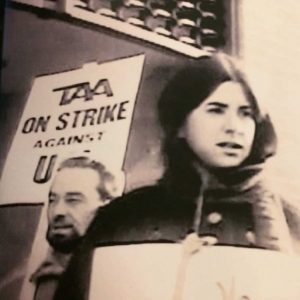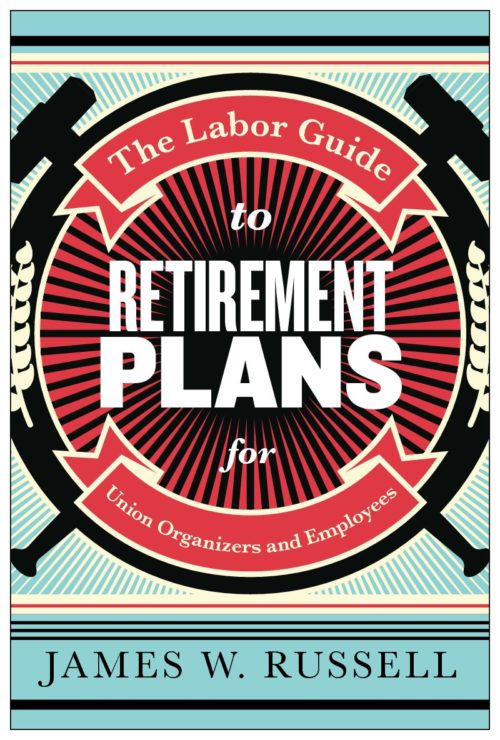The Labor Guide to Retirement Plans
For Union Organizers and Employees
256 pages, $24, 978-1-58367-933-3
by James W. Russell
Scroll down to listen to Jim Russell with Mark Gevaart on My Labor Radio, beneath this interview by Don McIntosh, for Northwest Labor Press
Sociologist James Russell’s academic career started at Lewis & Clark and ended at Portland State, but the bulk of it was at Eastern Connecticut State University. Soon after he arrived there he made what he later called the worst financial mistake of his life. A college HR rep gave him a choice and said he couldn’t later change his mind:
Enroll in the college’s 401(k) retirement savings plan, or its traditional pension. “Which should I choose?” Russell asked. The rep said a 401(k) would outperform a pension. That proved to be spectacularly wrong. Russell got active in his union, and won the right for him and his coworkers to get back in the pension. What he learned became the basis of a new book expressly for union members and leaders.
How did you become a pension expert and activist? In the book, you don’t really talk about the campaign you helped lead.
I taught at Lewis & Clark in the mid ‘80s, and then when I got a permanent job at Eastern Connecticut State University, they offered me a choice between a pension plan and a 401(k) type plan. Since I had been in a 401(k) type plan at Lewis & Clark, that seemed to be the logical thing to do. Well, I made the single biggest financial mistake of my life when I did that. About three or four years later, in 1992, I began to look into it, to see whether I’d made a mistake. I ran the numbers to see when I was 65 and retiring how much I would get out of the two different plans. I thought they would be kind of close. They were so dramatically different, that I thought I had made a mistake, and I re-ran the numbers. No. In fact, those of us in that 401(k) plan were paying into it twice as much money as the people in the pension plan and going to receive less than half the benefits. That’s how dramatically different it was.
So you were looking ahead, and you had this awful realization. Then what happened?
Well, I started telling other people about it. Their eyes kind of glazed over. I mean, they thought I was crazy because they thought they were on the way to becoming 401(k) millionaires, because the stock market was soaring at the time. So I basically got nowhere. I talked to unions. Nobody wanted to do anything. And they had said that it was an irrevocable choice. We couldn’t get out of it. Then, fast forward to 2008: The bottom of the market drops out. People in a 401(k) type of plan lost anywhere from 30% to 50% of their accumulated savings. Then people began to listen to me. We started with a meeting on our campus, which was pretty well attended. People were pretty angry. They were scared. And that mushroomed into a statewide organization. The unions at first thought there was nothing that could be done about it. But we ended up forming a rank and file inter-union movement, because there are a number of different unions that were involved. And I went all over the state explaining this and saying that the only solution to this problem was to allow us to roll our money that was in the 401(k) type plan, into the pension plan. It was a great revelation when we realized that this would actually save the state money. We didn’t start out knowing that. But we found that out.
That’s a powerful illustration of the union principle of “stronger together” — by pooling resources and risk, you end up with a better outcome than trying to do it on your own.
Absolutely. I mean, that’s the big advantage of pension plans is the risk sharing that’s involved. So a coalition of state employee unions filed a grievance on our behalf. We won the grievance, and the remedy was to allow us an opportunity, those who wanted to, to change plans, and we would buy in at actuarial value. So in 2013, basically we won that struggle. It’s one of the few victories like that.
So you went from being a voice in the wilderness in the early ‘90s to winning in 2013. One of the interesting things in your book was that you found there were academic economists who didn’t seem to understand the basic workings of a pension system.
When we had the opportunity to make the change, a lot of people didn’t know what to do. So I was fielding hundreds of letters from people, emails, I was still going around the state talking to people. People were coming to my office. I had to figure out a way to explain this. And I did, in about 20 minutes, I showed them what the benefits would be in this pension plan versus the benefits of that 401(k) plan. And then they walked out and made the change. And that included economists who are quoted in the New York Times. They really hadn’t paid attention.
Who is this book written for?
During that campaign, I realized that a lot of people in unions didn’t understand pension plans or retirement plans very well. They were called upon to give advice to members. And they didn’t know how to give advice to members, or worse, they gave bad advice. And I had some horror stories of people who really didn’t understand things. And then other people trusted them because they were associated with the union. So they must know. Okay, and then they gave terrible, terrible advice that really hurt people. So I think that there’s a need for broad labor education, both in terms of union activists but also anybody else who’s concerned about retirement plans. It’s a subject that, frankly, a lot of people think it’s really boring.
When I was reading your book, my wife was like, “What’s that? That sounds really boring.” And this is an issue. You start talking about pensions, and people think it’s boring. Why do you think that is?
I can only speculate. Maybe two reasons. It involves a lot of math. And people are averse to math. And it involves thinking about something that’s unpleasant— getting old. So people are kind of in denial. They just sort of let it ride. Let it go. Let it go. And then there’s just a feeling that this must be too technical to really understand. It’s like your insurance policy. Who wants to read all the clauses in your insurance policy?
….Social Security is not going broke. That that it needs to be defended at all costs, and expanded. Number two, if they have a pension plan, learn all about it, and defend it. And number three, if they [only] have a 401(k), look for reforms to try to get into a pension plan.
I’ve been thinking about this for a long time: For everybody has a 401(k), the question is, what do you do with it when you retire? With a 401(k) there’s this anxiety about whether you’re going to outlive your resources. How do you manage that? What’s your advice?
Most people are generally aware of the accumulation phase, and that it needs to grow and grow. But very few people have thought about what you do when you actually retire, to live off of this money. And the original idea was that you purchase an annuity from a life insurance company, which then guarantees you income for the rest of your life. Very few people do that, because those annuities have turned out to be extraordinarily expensive, for all kinds of reasons, including the fact that insurance companies are profit-making companies. So they’ve got you coming and going. I mean, they get you during the accumulation phase with their fees and commissions, and then when you spend it down they take more fees and commissions. So most people don’t do that. They just continue to invest.
Is the 4% rule a good recommendation? Can you explain that?
Well, the 4% rule is that you’re supposed to take out 4% of your balance the first year and then the next year 4% plus, whatever the increase in cost of living is. This guy ran all these figures in 50 years and showed that you wouldn’t outlive it. He has since had doubts about it. So they’re now lowering it to like 3%. So, it’s a way to think about it, but I don’t think it’s foolproof.
There’s another figure of the book, this rule of thumb that to be comfortable in retirement you need income equal to 70% of your final salary from all sources. That includes Social Security, pension, and private savings. Where does that 70% figure come from?
It’s just a rule of thumb. It’s the most often cited among financial advisors.
But is it valid? And why is it 70% and not 50 or 100?
It’s a good question. We don’t have an actual figure that we can scientifically say “that’s the one,” because everybody’s situation is different. If you retire as a single person, you need less than if you have dependents that you have responsibilities for. If you retire with a paid off house, it’s different than if you’re still paying rent somewhere. If you have a good insurance plan, that’s one thing. If you don’t have a good insurance plan, yeah, you tend to get sicker and more expensive illnesses when you get old….
Read the interview in full at NW Labor Press and listen below to Jim Russell with Mark Gevaart on My Labor Radio.
Also! The 1970 Wisconsin Teaching Assistant Strike: Archival footage, edited by James Russell of “The Labor Guide to Retirement Plans”
Jim Russell recently put out a new documentary based on hardly-seen raw archival footage. It is the story of the strike that launched the first graduate student employee union in the country, the union that has continued to represent Wisconsin TAs for over fifty years.
In March 1970, the Teaching Assistants Association at the University of Wisconsin went out on strike for twenty-four days. It was the first TA strike in the history of the United States. With university strikes and organizing going on all over the country today, Russell’s new documentary has special significance. Wrote Maynard Seider, writer/director of “Farewell to Factory Towns?”: “The black and white footage, and the words and actions, of these pathbreaking teaching assistants back in 1970, speak to us today, of courage, union solidarity, and what it takes to challenge the boss, be it a university chancellor or an Amazon CEO.”
You can find the new documentary by going to the Marxism-Leninism Today site


Comments are closed.